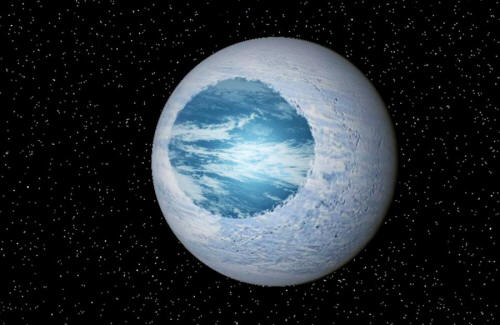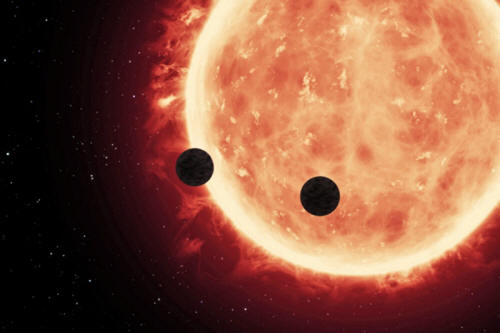|
a water world where the sun-facing side is able to maintain a liquid-water ocean.
Credit and Copyright:
eburacum45/ DeviantArt
And why not? As the closest extrasolar
planet to our Solar System, it is the best shot we have at studying
exoplanets up close in the near future.
And now, researchers from the University of Bern have taken this analysis a step further.
Based on their study (Formation and Composition of Planets Around Very Low Mass Stars), which has been accepted for publication in the journal Astronomy and Astrophysics (A&A), they have determined that the majority planets that form within the habitable zones of a red dwarf star may be water worlds.
These findings could have drastic implications for the search for habitable exoplanets around red dwarf stars.
The research was conducted by Dr. Yann Alibert from the National Centers for Competence in Research (NCCR) and Prof. Willy Benz from the Center of Space and Habitability (CSH).
Both of these institutions, which are located at the University of Bern, are dedicated to understanding planetary formation and evolution, as well as fostering a dialogue with the public about exoplanet research.
An artist's depiction of planets transiting a red dwarf star in the TRAPPIST-1 System. Credit: NASA/ESA/STScl
For the sake of their study, Alibert and Benz carried out the first computer simulation designed to examine the formation of planets around stars that are ten times less massive than our Sun.
This involved creating a model that included hundreds of thousands of identical low-mass stars, which were then given orbiting proto-planetary disks of dust and gas.
They then simulated what would happen if planets began to form from the accretion of these disks.
For each, they assumed the existence of ten "planetary embryos" (equal to the mass of the Moon) which would grow and migrate over time, giving rise to a system of planets.
Ultimately, what they found was that the planets orbiting within the habitable zone of their parent star would likely to be comparable in size to Earth - ranging from 0.5 to 1.5 times the radius of Earth, with 1 Earth radii being the average.
As Dr. Yann Alibert explained us via email:
Artist's impression of the view from the most distant exoplanet discovered around the red dwarf star TRAPPIST-1. Credit: ESO/M. Kornmesser.
In addition, the simulations produced some interesting estimates on how much of the planets would consist of water.
In 90% of cases, water would account for more than 10% of the planets' mass. Compare that to Earth, where water covers over 70% of our surface, but makes up only about 0.02% of our planet's total mass.
This would mean that the exoplanets would have very deep oceans and a layer of ice at the bottom, owing to the extreme pressure.
Last, but not least, Alibert and Benze found that if the proto-planetary disks that these planets formed from lived longer than the models suggested, the situation would be even more extreme.
All of this could be dire news for those hoping that we might find ET living next door, or that red dwarf stars are the best place to look for intelligent life.
However, Alibert indicates that these two studies were conducted based on planets that orbit stars similar to our Sun.
Red dwarfs are different because they evolve much slower (i.e. the luminosity changes very slowly over time) and they are far more red than our Sun, meaning that the light coming from them has different wavelengths that will interact different with planetary atmospheres.
Artist's impression of the planet Proxima b orbiting the red dwarf star Proxima Centauri, the closest star to the Solar System. Credit: ESO/M. Kornmesser
But regardless of whether or not planets that orbit red dwarf stars are habitable, simulations like this one are still exciting.
Aside from offering data on what neighboring planets might look like, they also help us to understand the wide range of possibilities that await us out there. And last, they give us more incentive to actually get out there and explore these worlds up close.
Only by sending missions to other stars can we confirm or deny if they are capable of supporting life.
And if in the end, we should find that the most common star in the Universe is unlikely to produce life-giving planets, it only serves to remind us how rare and precious "Earth-like" planets truly are.
Additional Information
|





